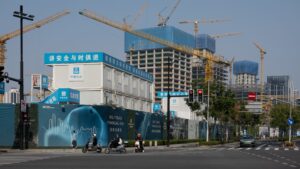China’s Economic Landscape: Insights and Implications for Investors

As of November 4, 2024, the ongoing developments in Shanghai exemplify the dynamic shifts within China’s economy. Recent data from the National Bureau of Statistics indicates a modest economic recovery as the country endeavors to stimulate domestic consumption. To understand the implications of these developments, let’s delve into the latest figures and explore what they mean for both local investors and those looking to navigate the broader economic landscape.
Economic Performance: Key Indicators
Retail Sales Surge
China’s retail sales saw a notable uptick of 4.0% in the first two months of the year, a positive sign compared to December’s 3.7% year-on-year growth. This increase aligns with Reuters’ forecasts, suggesting a stabilization in consumer spending—a crucial element of the economy.
Industrial Production and Investment
Industrial production rose by 5.9%, albeit a slight dip from December’s 6.2%. However, it was still above the market’s expectations of 5.3%. The accelerated growth in high-tech manufacturing (9.1%) and equipment manufacturing (10.6%) reveals a shift towards more advanced capabilities, enhancing prospects for future economic resilience.
In terms of fixed asset investment, a 4.1% year-to-date increase outperformed economists’ expectations of 3.6%, indicating a rebound from last year’s 3.2% growth. This is a positive indicator for investors looking for opportunities in the tangible asset space.
The National Bureau of Statistics attributes these changes partly to ongoing stimulus measures from Beijing. However, they also pointed out "insufficient domestic demand" as a persistent issue. This highlights a critical point for potential investors: understanding the drivers behind consumer behavior is vital for making informed investment choices.
Policy Adjustments and Future Planning
In response to recent economic challenges, Chinese policymakers have outlined plans to stimulate domestic consumption further. These initiatives include supporting residents’ incomes, enhancing tourism, and stabilizing the stock market. Importantly, the introduction of a childcare subsidy scheme signifies a structural effort to boost household spending.
While these high-level plans lack specific implementation details, they offer insights into the government’s intent to address longstanding issues, such as income growth stagnation and an insufficient social safety net. As Lynn Song, chief China economist at ING noted, this direction hints at a gradual transition towards a more consumption-driven economy—a development that could create diverse investment prospects within the consumer sector.
Employment and Real Estate Dynamics
Despite positive momentum in some sectors, urban unemployment reached 5.4%—the highest level in two years—which indicates that challenges remain. Moreover, the property market showed a mixed performance; new home prices fell but at a slower rate than previous months. The reduction in investment for real estate development underscores the need for ongoing credit support for developers, which remains vital amid tightening financial conditions.
Setting a Growth Target Amid Complex Challenges
China’s leadership has set a challenging growth target of "around 5%" for the year, a goal appearing increasingly difficult to achieve given escalating trade tensions and persistent deflationary pressures. As Fu Lingui from the statistics bureau remarked, meeting this target will not be easy. Economists believe that stronger stimulus measures will be essential to shore up domestic consumption, particularly as exports, which contributed nearly a quarter of China’s GDP last year, face potential declines.
February’s consumer price index reflected a concerning trend—with inflation dipping below zero for the first time in over a year. This prompted the government to lower its annual inflation target to a historic low of "around 2%." These changes signal an overt acknowledgment of the current deflationary landscape, suggesting that investors must remain vigilant as the economic environment evolves.
In a move to counteract these pressures, Chinese leaders have pledged to issue an additional 300 billion yuan (approximately $41.5 billion) in special treasury bonds aimed at consumer subsidies. While this could enhance liquidity, analysts stress the need for these measures to target consumers more directly to achieve lasting impacts.
Conclusion: What This Means for Investors
The current economic climate in China presents a unique convergence of opportunity and challenge. Investors keenly aware of the shifting dynamics—from government initiatives to consumer behavior—stand to gain insight into strategically positioning their portfolios in this complex economic framework.
As you navigate the evolving landscape, keep an eye on the implications of policy changes, consumer trends, and sector-specific performances. At Extreme Investor Network, we deliver insights that empower you to make informed decisions in an ever-changing market, ensuring you’re not just reacting, but anticipating the next moves in this global economic chess game.

